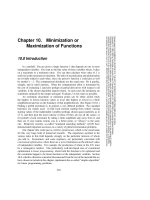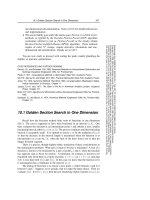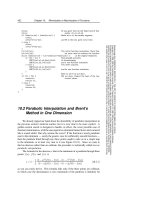Tài liệu Minimization or Maximization of Functions part 8 ppt
Bạn đang xem bản rút gọn của tài liệu. Xem và tải ngay bản đầy đủ của tài liệu tại đây (154.4 KB, 6 trang )
10.7 Variable Metric Methods in Multidimensions
425
Sample page from NUMERICAL RECIPES IN C: THE ART OF SCIENTIFIC COMPUTING (ISBN 0-521-43108-5)
Copyright (C) 1988-1992 by Cambridge University Press.Programs Copyright (C) 1988-1992 by Numerical Recipes Software.
Permission is granted for internet users to make one paper copy for their own personal use. Further reproduction, or any copying of machine-
readable files (including this one) to any servercomputer, is strictly prohibited. To order Numerical Recipes books,diskettes, or CDROMs
visit website or call 1-800-872-7423 (North America only),or send email to (outside North America).
*fret=dbrent(ax,xx,bx,f1dim,df1dim,TOL,&xmin);
for (j=1;j<=n;j++) { Construct the vector results to return.
xi[j] *= xmin;
p[j] += xi[j];
}
free_vector(xicom,1,n);
free_vector(pcom,1,n);
}
#include "nrutil.h"
extern int ncom; Defined in dlinmin.
extern float *pcom,*xicom,(*nrfunc)(float []);
extern void (*nrdfun)(float [], float []);
float df1dim(float x)
{
int j;
float df1=0.0;
float *xt,*df;
xt=vector(1,ncom);
df=vector(1,ncom);
for (j=1;j<=ncom;j++) xt[j]=pcom[j]+x*xicom[j];
(*nrdfun)(xt,df);
for (j=1;j<=ncom;j++) df1 += df[j]*xicom[j];
free_vector(df,1,ncom);
free_vector(xt,1,ncom);
return df1;
}
CITED REFERENCES AND FURTHER READING:
Polak, E. 1971,
Computational Methods in Optimization
(New York: Academic Press),
§
2.3. [1]
Jacobs, D.A.H. (ed.) 1977,
The State of the Art in Numerical Analysis
(London: Academic
Press), Chapter III.1.7 (by K.W. Brodlie). [2]
Stoer, J., and Bulirsch, R. 1980,
Introduction to Numerical Analysis
(New York: Springer-Verlag),
§
8.7.
10.7 Variable Metric Methods in
Multidimensions
The goal of variable metric methods, which are sometimes called quasi-Newton
methods, is not different from the goal of conjugate gradient methods: to accumulate
information from successive line minimizations so that N such line minimizations
lead to the exact minimum of a quadratic form in N dimensions. In that case, the
method will also be quadratically convergent for more general smooth functions.
Both variable metric andconjugate gradient methods require that you are able to
compute your function’s gradient, or first partial derivatives, at arbitrary points. The
variable metric approach differs from the conjugate gradient in the way that it stores
426
Chapter 10. Minimization or Maximization of Functions
Sample page from NUMERICAL RECIPES IN C: THE ART OF SCIENTIFIC COMPUTING (ISBN 0-521-43108-5)
Copyright (C) 1988-1992 by Cambridge University Press.Programs Copyright (C) 1988-1992 by Numerical Recipes Software.
Permission is granted for internet users to make one paper copy for their own personal use. Further reproduction, or any copying of machine-
readable files (including this one) to any servercomputer, is strictly prohibited. To order Numerical Recipes books,diskettes, or CDROMs
visit website or call 1-800-872-7423 (North America only),or send email to (outside North America).
and updates the information that is accumulated. Instead of requiring intermediate
storage on the order of N, the number of dimensions, it requires a matrix of size
N × N. Generally, for any moderate N, this is an entirely trivial disadvantage.
On the other hand, there is not, as far as we know, any overwhelmingadvantage
that the variable metric methods hold over the conjugate gradient techniques, except
perhaps a historical one. Developed somewhat earlier, and more widely propagated,
the variable metric methods have by now developed a wider constituency of satisfied
users. Likewise, some fancier implementations of variable metric methods (going
beyond the scope of this book, see below) have been developed to a greater level of
sophistication on issues like the minimization of roundoff error, handling of special
conditions, and so on. We tend to use variable metric rather than conjugate gradient,
but we have no reason to urge this habit on you.
Variablemetricmethodscomeintwomainflavors. OneistheDavidon-Fletcher-
Powell (DFP) algorithm (sometimes referred to as simply Fletcher-Powell). The
other goes by the name Broyden-Fletcher-Goldfarb-Shanno (BFGS).TheBFGSand
DFP schemes differ only in details of their roundoff error, convergence tolerances,
and similar “dirty” issues which are outside of our scope
[1,2]
. However, it has
become generally recognized that, empirically, the BFGS scheme is superior in these
details. We will implement BFGS in this section.
As before, we imagine that our arbitrary function f(x) can be locally approx-
imated by the quadratic form of equation (10.6.1). We don’t, however, have any
information about the values of the quadratic form’s parameters A and b, except
insofar as we can glean such information from our function evaluations and line
minimizations.
The basic idea of the variable metric method is to build up, iteratively, a good
approximation to the inverse Hessian matrix A
−1
, that is, to construct a sequence
of matrices H
i
with the property,
lim
i→∞
H
i
= A
−1
(10.7.1)
Even better if the limit is achieved after N iterations instead of ∞.
The reason that variable metric methods are sometimes called quasi-Newton
methods can now be explained. Consider finding a minimum by using Newton’s
method to search for a zero of the gradient of the function. Near the current point
x
i
, we have to second order
f(x)=f(x
i
)+(x−x
i
)·∇f(x
i
)+
1
2
(x−x
i
)·A·(x−x
i
)(10.7.2)
so
∇f(x)=∇f(x
i
)+A·(x−x
i
)(10.7.3)
In Newton’s method we set ∇f(x)=0to determine the next iteration point:
x − x
i
= −A
−1
·∇f(x
i
)(10.7.4)
The left-hand side is the finite step we need take to get to the exact minimum; the
right-hand side is known once we have accumulated an accurate H ≈ A
−1
.
The “quasi” in quasi-Newton is because we don’t use the actual Hessian matrix
of f, but instead use our current approximation of it. This is often better than
10.7 Variable Metric Methods in Multidimensions
427
Sample page from NUMERICAL RECIPES IN C: THE ART OF SCIENTIFIC COMPUTING (ISBN 0-521-43108-5)
Copyright (C) 1988-1992 by Cambridge University Press.Programs Copyright (C) 1988-1992 by Numerical Recipes Software.
Permission is granted for internet users to make one paper copy for their own personal use. Further reproduction, or any copying of machine-
readable files (including this one) to any servercomputer, is strictly prohibited. To order Numerical Recipes books,diskettes, or CDROMs
visit website or call 1-800-872-7423 (North America only),or send email to (outside North America).
using the true Hessian. We can understand this paradoxical result by considering the
descent directions of f at x
i
. These are the directions p along which f decreases:
∇f ·p < 0. For the Newton direction(10.7.4) to be a descent direction, we musthave
∇f(x
i
) · (x − x
i
)=−(x−x
i
)·A·(x−x
i
)<0(10.7.5)
that is, A must be positive definite. In general, far from a minimum, we have no
guarantee that the Hessian is positive definite. Taking the actual Newton step with
the real Hessian can move us to points where the function is increasing in value.
The idea behind quasi-Newton methods is to start with a positivedefinite, symmetric
approximation to A (usually the unit matrix) and build up the approximating H
i
’s
in such a way that the matrix H
i
remains positive definite and symmetric. Far from
the minimum, this guarantees that we always move in a downhill direction. Close to
the minimum, the updating formula approaches the true Hessian and we enjoy the
quadratic convergence of Newton’s method.
When we are not close enough to the minimum, taking the full Newton step
p even with a positive definite A need not decrease the function; we may move
too far for the quadratic approximation to be valid. All we are guaranteed is that
initially f decreases as we move in the Newton direction. Once again we can use
the backtracking strategy described in §9.7 to choose a step along the direction of
the Newton step p, but not necessarily all the way.
We won’t rigorously derive the DFP algorithm for taking H
i
into H
i+1
; you
can consult
[3]
for clear derivations. Following Brodlie (in
[2]
), we will give the
following heuristic motivation of the procedure.
Subtracting equation (10.7.4) at x
i+1
from that same equation at x
i
gives
x
i+1
− x
i
= A
−1
· (∇f
i+1
−∇f
i
)(10.7.6)
where ∇f
j
≡∇f(x
j
). Having made the step from x
i
to x
i+1
, we might reasonably
want to require that the new approximation H
i+1
satisfy (10.7.6) as if it were
actually A
−1
,thatis,
x
i+1
− x
i
= H
i+1
· (∇f
i+1
−∇f
i
)(10.7.7)
We might also imagine that the updating formula should be of the form H
i+1
=
H
i
+ correction.
What “objects” are around out of which to construct a correction term? Most
notable are the two vectors x
i+1
− x
i
and ∇f
i+1
−∇f
i
; and there is also H
i
.
There are not infinitely many natural ways of making a matrix out of these objects,
especially if (10.7.7) must hold! One such way, the DFP updating formula,is
H
i+1
= H
i
+
(x
i+1
− x
i
) ⊗ (x
i+1
− x
i
)
(x
i+1
− x
i
) · (∇f
i+1
−∇f
i
)
−
[H
i
·(∇f
i+1
−∇f
i
)] ⊗ [H
i
· (∇f
i+1
−∇f
i
)]
(∇f
i+1
−∇f
i
)·H
i
·(∇f
i+1
−∇f
i
)
(10.7.8)
where ⊗ denotes the “outer” or “direct” product of two vectors, a matrix: The ij
componentof u⊗v is u
i
v
j
. (You mightwant to verifythat10.7.8 does satisfy 10.7.7.)
428
Chapter 10. Minimization or Maximization of Functions
Sample page from NUMERICAL RECIPES IN C: THE ART OF SCIENTIFIC COMPUTING (ISBN 0-521-43108-5)
Copyright (C) 1988-1992 by Cambridge University Press.Programs Copyright (C) 1988-1992 by Numerical Recipes Software.
Permission is granted for internet users to make one paper copy for their own personal use. Further reproduction, or any copying of machine-
readable files (including this one) to any servercomputer, is strictly prohibited. To order Numerical Recipes books,diskettes, or CDROMs
visit website or call 1-800-872-7423 (North America only),or send email to (outside North America).
The BFGS updating formula is exactly the same, but with one additional term,
··· +[(∇f
i+1
−∇f
i
)·H
i
·(∇f
i+1
−∇f
i
)] u ⊗ u (10.7.9)
where u is defined as the vector
u ≡
(x
i+1
− x
i
)
(x
i+1
− x
i
) · (∇f
i+1
−∇f
i
)
−
H
i
·(∇f
i+1
−∇f
i
)
(∇f
i+1
−∇f
i
)·H
i
·(∇f
i+1
−∇f
i
)
(10.7.10)
(You might also verify that this satisfies 10.7.7.)
You will have to take on faith — or else consult
[3]
for details of — the “deep”
result that equation (10.7.8), with or without (10.7.9), does in fact converge to A
−1
in N steps, if f is a quadratic form.
Here now is the routine dfpmin that implements the quasi-Newton method, and
uses lnsrch from §9.7. As mentioned at the end of newt in §9.7, this algorithm
can fail if your variables are badly scaled.
#include <math.h>
#include "nrutil.h"
#define ITMAX 200 Maximum allowed number of iterations.
#define EPS 3.0e-8 Machine precision.
#define TOLX (4*EPS) Convergence criterion on x values.
#define STPMX 100.0 Scaled maximum step length allowed in
line searches.
#define FREEALL free_vector(xi,1,n);free_vector(pnew,1,n); \
free_matrix(hessin,1,n,1,n);free_vector(hdg,1,n);free_vector(g,1,n); \
free_vector(dg,1,n);
void dfpmin(float p[], int n, float gtol, int *iter, float *fret,
float(*func)(float []), void (*dfunc)(float [], float []))
Given a starting point
p[1..n]
that is a vector of length
n
, the Broyden-Fletcher-Goldfarb-
Shanno variant of Davidon-Fletcher-Powell minimization is performed on a function
func
,using
its gradient as calculated by a routine
dfunc
. The convergence requirement on zeroing the
gradient is input as
gtol
. Returned quantities are
p[1..n]
(the location of the minimum),
iter
(the number of iterations that were performed), and
fret
(the minimum value of the
function). The routine
lnsrch
is called to perform approximate line minimizations.
{
void lnsrch(int n, float xold[], float fold, float g[], float p[], float x[],
float *f, float stpmax, int *check, float (*func)(float []));
int check,i,its,j;
float den,fac,fad,fae,fp,stpmax,sum=0.0,sumdg,sumxi,temp,test;
float *dg,*g,*hdg,**hessin,*pnew,*xi;
dg=vector(1,n);
g=vector(1,n);
hdg=vector(1,n);
hessin=matrix(1,n,1,n);
pnew=vector(1,n);
xi=vector(1,n);
fp=(*func)(p); Calculate starting function value and gra-
dient,(*dfunc)(p,g);
for (i=1;i<=n;i++) { and initialize the inverse Hessian to the
unit matrix.for (j=1;j<=n;j++) hessin[i][j]=0.0;
hessin[i][i]=1.0;
xi[i] = -g[i]; Initial line direction.
sum += p[i]*p[i];
}
stpmax=STPMX*FMAX(sqrt(sum),(float)n);
10.7 Variable Metric Methods in Multidimensions
429
Sample page from NUMERICAL RECIPES IN C: THE ART OF SCIENTIFIC COMPUTING (ISBN 0-521-43108-5)
Copyright (C) 1988-1992 by Cambridge University Press.Programs Copyright (C) 1988-1992 by Numerical Recipes Software.
Permission is granted for internet users to make one paper copy for their own personal use. Further reproduction, or any copying of machine-
readable files (including this one) to any servercomputer, is strictly prohibited. To order Numerical Recipes books,diskettes, or CDROMs
visit website or call 1-800-872-7423 (North America only),or send email to (outside North America).
for (its=1;its<=ITMAX;its++) { Main loop over the iterations.
*iter=its;
lnsrch(n,p,fp,g,xi,pnew,fret,stpmax,&check,func);
The new function evaluation occurs in lnsrch; save the function value in fp for the
next line search. It is usually safe to ignore the value of check.
fp = *fret;
for (i=1;i<=n;i++) {
xi[i]=pnew[i]-p[i]; Update the line direction,
p[i]=pnew[i]; and the current point.
}
test=0.0; Test for convergence on ∆x.
for (i=1;i<=n;i++) {
temp=fabs(xi[i])/FMAX(fabs(p[i]),1.0);
if (temp > test) test=temp;
}
if (test < TOLX) {
FREEALL
return;
}
for (i=1;i<=n;i++) dg[i]=g[i]; Save the old gradient,
(*dfunc)(p,g); and get the new gradient.
test=0.0; Test for convergence on zero gradient.
den=FMAX(*fret,1.0);
for (i=1;i<=n;i++) {
temp=fabs(g[i])*FMAX(fabs(p[i]),1.0)/den;
if (temp > test) test=temp;
}
if (test < gtol) {
FREEALL
return;
}
for (i=1;i<=n;i++) dg[i]=g[i]-dg[i]; Compute difference of gradients,
for (i=1;i<=n;i++) { and difference times current matrix.
hdg[i]=0.0;
for (j=1;j<=n;j++) hdg[i] += hessin[i][j]*dg[j];
}
fac=fae=sumdg=sumxi=0.0; Calculate dot products for the denomi-
nators.for (i=1;i<=n;i++) {
fac += dg[i]*xi[i];
fae += dg[i]*hdg[i];
sumdg += SQR(dg[i]);
sumxi += SQR(xi[i]);
}
if (fac > sqrt(EPS*sumdg*sumxi)) { Skip update if fac not sufficiently posi-
tive.fac=1.0/fac;
fad=1.0/fae;
The vector that makes BFGS different from DFP:
for (i=1;i<=n;i++) dg[i]=fac*xi[i]-fad*hdg[i];
for (i=1;i<=n;i++) { The BFGS updating formula:
for (j=i;j<=n;j++) {
hessin[i][j] += fac*xi[i]*xi[j]
-fad*hdg[i]*hdg[j]+fae*dg[i]*dg[j];
hessin[j][i]=hessin[i][j];
}
}
}
for (i=1;i<=n;i++) { Now calculate the next direction to go,
xi[i]=0.0;
for (j=1;j<=n;j++) xi[i] -= hessin[i][j]*g[j];
}
} and go back for another iteration.
nrerror("too many iterations in dfpmin");
FREEALL
}









